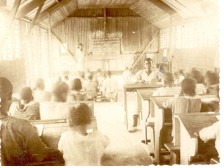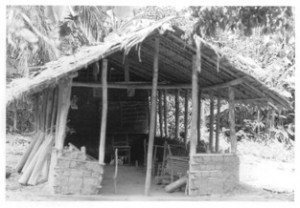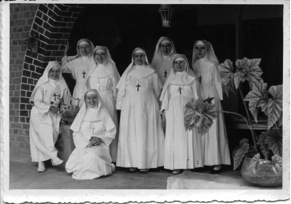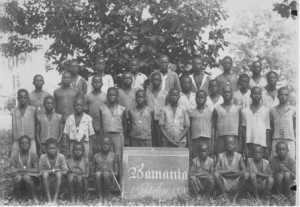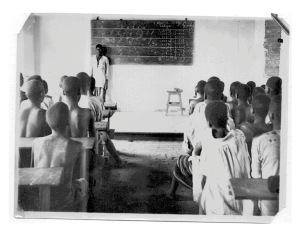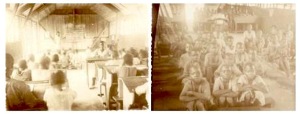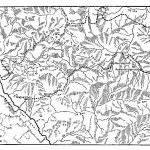When Congo Wants To Go To School – Educational Organisation In The Belgian Congo (1908-1958)
Contexts
The first part of this study will concentrate on the wider environment within which daily practice of colonial education is situated. It progresses in three stages in accordance with the aim of the research. Three chapters correspond with these three stages. The general, macro-institutional context of the phenomenon of colonial education is considered in the first chapter. This includes a discussion of the organisational development and politico-strategic factors that influenced this phenomenon. The development of the educational structures is indicated from the angle of the interaction between state intervention and the Catholic initiative. Within that framework the major themes in the content and emphasis of colonial lesson plans are also considered, as are the opinions on these subjects. Finally, figures are given to allow an estimate of the quantitative development of education in the colony. The second chapter shifts the focus to Belgium. The preparation, training, ideas and worldview with which the missionaries left for the Belgian Congo will be considered more closely. This chapter is divided into two parts. The first part considers a number of broad social and historical factors that played a part in the formation of the missionaries’ general intellectual baggage. Mainly results of existing research are presented and discussed in this part. The second part takes a closer look at the people who are of specific interest to us, covering the preparation and training given to the Sacred Heart Missionaries in Belgium and using specific source material. In the third chapter we make the journey to the Congo together with these missionaries. A number of elements are given in a short outline that also constitute the direct context of their work. Firstly, a description is given of the creation and growth of the mission region in which they were active. Then follows the introduction of the other missionary congregations, with which the Sacred Heart Missionaries cooperated. Finally, quantitative data are brought together with regard to the development of education, both for the mission region as a whole and for the various mission posts separately. Read more
When Congo Wants To Go To School – The Missionaries And The Belgian Congo: Preparation, Ideas And Conceptions Of The Missionaries
“I have been interested in the Congo all my life, because I always wanted to be a missionary in the Congo, even as a little child. And so in a way I paid some attention to it, but only the achievements of my heroes at the time – a number of family members were missionaries and the mission exhibitions, the missionary action. The Congo came to us through missionary work and it was very heroic. …I remember the moment to the minute when I discovered the background or the ‘depths’ of the colonisation of the Belgian Congo. And then I got the feeling, which I still have today, that during my training, my education, I had been deceived about the Congo.“[1]
Flemish and, by extension, Belgian missionaries left for the Belgian Congo in droves. The Statistical Yearbook of the N.I.S., which had a separate section for the colony, recorded a few tables with data about the ‘white’ population. As well as divisions on the basis of nationality, gender and place of residence, for a number of years it also included a “class division“. In this table, the population was divided into three categories: ‘civil servant’, ‘missionaries’ and ‘general public’. The presence of a separate category for missionaries points to the fact that they were very important in colonial society. On the basis of the available figures it can be posited that during the interbellum period, religious workers comprised 10 to 15% of the white population. This percentage was certainly not only men, the proportion of female religious workers was fairly stable throughout the colonial period and amounted to over 40%.[2]
When Congo Wants To Go To School – Catholic Missions in the Tshuapa Region
To give a more coherent picture of the development of education in the region studied, it is necessary to start with a brief explanation of the development of the church hierarchy in the region and the way in which this was concretized by the religious orders that would become responsible for education. This subject will be covered in this chapter in two parts. The first part handles the evolution of the church hierarchy in a strict sense and the delineation of what would eventually become the mission area of the MSC. The presence and missionary work of the Trappists in the area will be discussed first. Chronologically, this history only begins once this congregation had decided to leave the Congo, but it is useful to consider a number of events from the preceding period in order to understand the activities of the MSC properly. The identity and presence of the other religious orders in the mission region and their involvement in education will then be outlined. Finally, the second part will describe a quantitative development of the schools in the vicariate on the basis of a number of statistical data. This will enable us to give the direct context of the reality in the classroom that will be considered in more detail in the second part.
1. The missionary presence
1.1. How the missionaries of the Sacred Heart obtained a vicariate in the Congo
In the church hierarchy, the area around Mbandaka and the Tshuapa was originally a part of the apostolic vicariate of the Belgian Congo, founded in 1888. It was put under the leadership of the congregation of Scheut, which was the first Belgian congregation to send missionaries to the Congo.[i] Naturally, in subsequent years the evangelisation of the Congo Free State as a whole expanded further, the number of congregations active in the Congo greatly increased and the administrative church structure was repeatedly adapted.
1.1.1. The Trappists of Westmalle on the Equator[ii]
Chronologically, the protestant Livingstone Inland Mission was the first to establish itself at the mouth of the Ruki in the Congo River. That was in Wangata in 1883. In the same year and in the same place, Stanley, together with the officers Coquilhat and Vangele,[iii] founded the state post Equateurville, which was clearly separated from the mission that had been set up earlier.[iv] In 1895 the monopoly of the Protestants in the region ended with the arrival of the first Trappists.[v] The original intention of this contemplative order was the establishment of a closed monastic community in Bamanya, about eight kilometres from Equateurville, “following the example of the monks in the middle ages.“[vi]
Thanks to its strategic situation at the confluence of two important rivers, Equateurville, renamed Coquilhatville from 1892, developed rather quickly to become a so-called circonscription urbaine.[vii]Nevertheless, it would take until 1902 before the Trappists, at the request of the colonial administration, set up the parish of Boloko wa Nsimba, still “forty minutes away from the state post of Coquilhatville“.[viii] Meanwhile, the developing state post was abandoned by the Protestants. The post of Wangata was moved to Bolenge (about ten kilometres outside Coquilhatville) and the Livingstone Inland Mission was replaced by the Disciples of Christ Congo Mission.[ix] Even before the First World War, the Trappists built a church in Coquilhatville and provided evangelical teaching there. Even so, their activities in this urban environment remained very limited. Marchal says in this regard: “The trappists, simple people from the rural Kempen region, had an aversion to great centres.”[x] In the twenties the General Chapter in Rome decided that the Trappists of Westmalle had to leave the Congo and return to their monastic way of life, which was considered irreconcilable with the missionary work in the Congo.[xi] In 1926 the Missionaries of the Sacred Heart of Issoudun (hereafter referred to by their official abbreviation “MSC”) took over their area. Read more
When Congo Wants To Go To School – Part II – Realities
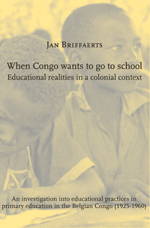 In the following chapters I will try to reconstruct the educational reality in the schools of the MSC based primarily on the written sources available. More specifically, this relates to the reconstruction of classroom life and the educational relationship between missionaries and pupils. The closer one gets to the so-called ‘micro level’, the more apparent it becomes that it is almost impossible to make a true reconstruction in the sense of a true representation, “wie es eigentlich gewesen ist”, of the educational relationship between missionaries and Congolese. Naturally, the source material available is important here and defines the boundaries within which the research can be carried out.
In the following chapters I will try to reconstruct the educational reality in the schools of the MSC based primarily on the written sources available. More specifically, this relates to the reconstruction of classroom life and the educational relationship between missionaries and pupils. The closer one gets to the so-called ‘micro level’, the more apparent it becomes that it is almost impossible to make a true reconstruction in the sense of a true representation, “wie es eigentlich gewesen ist”, of the educational relationship between missionaries and Congolese. Naturally, the source material available is important here and defines the boundaries within which the research can be carried out.
A second important matter is that the teaching was not given by the missionaries in the first place, but by the Congolese. This is not unique to the Missionaries of the Sacred Heart, it is more generally true for the entire colony. From the beginning an appeal was made to native assistance, to carry out the huge quantity of work caused by the evangelisation project. A decision was already made in 1907 by the bishops in the Congo to establish a central teacher-training course for each church province. The reason for this was of course the unbalance between the personnel available and the population to be reached. The fact that evangelisation was much more important to the missionaries than the educational activity meant that it was “sufficient” initially to train the Congolese as catechists and that it was not necessary in the strict sense to train teachers. This was also emphasised in those first plans: the candidates for training had to be young (maximum 12 years old) and it was explicitly stated that the intention was not to train educationalists but catechists as assistants to the missionaries.[i] According to Antoine Dibalu there were 11 central teacher-training colleges in 1922, of which those closest to the Equator province were situated in Nouvel Anvers (North of Coquilhatstad) and in Tumba (by Lake Tumba, South of Coquilhatstad).[ii] However, it is likely that not everybody who became teaching assistant had actually attended a teacher training college. That was certainly true in the mission region of the MSC.[iii] One example of this can be found in the Annals from 1929: “On Tuesday there is a school inspection. Notwithstanding all kinds of unfavourable circumstances satisfactory results have been achieved. The head teaching assistant, Georges Lobombe, although he has not had any professional training, was given an honorary mention in the inspector’s report.”[iv][v]
From a statistical summary from 1934 it is apparent that a little over 120 “white” religious workers were working in the vicariate Coquilhatstad, together with 90 teachers and 357 catechists. It was also stated that there were another eighty pupils or so at the teacher training college at that time. Consequently, an attempt was made to have trained teachers but that was clearly not always the case. Moreover, the same was true for the missionaries themselves. They had, barring a few exceptions, no educational training. The missionaries’ role was often limited to supervising the teaching assistants and to giving religious education. One of the many testimonies in this regard was given in the Annals by Sister Godfrieda, a Sister of the Sacred Heart, who worked in the newly established mission post in Bolima from 1934: “Here you will find Sr. M. Godfrieda, who tries to keep order with two black helpers among the three hundred and fifty rascals and to drum the first concepts of discipline, prayer and the catechism into them and to teach them some letters and arithmetic.”[vi] Relatively speaking, more people with educational training could be found among the sisters than at the MSC. The MSC were not a teaching order by nature. Consequently, it should not be surprising that when a large school had to be established in a central place, as in Coquilhatville, the Brothers of the Christian Schools were appealed to, being traditionally considered an educational congregation. Read more
When Congo Wants To Go To School – The Educational Climate
Moral foundation and worldview
The clear moralising impact of the curricular was indicated in the previous chapter. This moralising also seems a very good reflection of the climate in which missionary intervention and education took place. This fact was very clearly brought to the fore in the mission periodical of the MSC. It was repeatedly pointed out that, as far as the missionaries were concerned, Christianisation was the most important concern. This remained the same throughout the colonial period, although it levelled off towards the end and was concealed by other, more worldly-oriented educational objectives. In 1926, one of the MSC pioneers, Father Es, wrote about the settlement in Boende: “We are situated on a small plateau in the middle of the tropical forest, far from the state outpost and every native village, so as to reduce the influence of the heathens and the whites to a minimum. The purer the Christian atmosphere, the better the Christians.“[i] The same Father Es wrote about the lessons themselves: “Those classes, as dull and monotonous as they are – we know from our own experience of taking them as children – do not bore them. They constantly ask for more. And together with these reading, writing, drawing and maths lessons, the Christian spirit penetrates their heart drop-by-drop. Everything on the mission breathes this exalted spirit which will only make them more human. Our goal is after all not only to form developed Negroes, but also developed Christians.“[ii]
The statements made in the Annals sound disarming to contemporary ears, sometimes even shockingly naïve. For this reason they are a good indicator of the state of affairs. The opinions in the metropolis were not so different or more ‘elevated’ that they needed to mince words. In the end of year edition of the Annals in 1931 the following could be read: “Why mission expansion? Because we need money, our beautiful mission territory around the equator forest, which is six times bigger than Belgium, needs to be provided with more priests, more Brothers, more churches, more schools. Why mission expansion? Because otherwise the Protestants will take advantage! Because otherwise the Protestants, with all their gold, will stack the best part of the harvest in their own stores. (…) Why expansion? Because the need for souls is so great that the waves engulf the ship of the church.”[iii] That there was a need for souls was obvious to all missionaries and to the home front. That something needed to be done about it was at least as obvious to the missionaries. And the competitive element towards other religious convictions naturally became a part of this.[iv]
Petrus Vertenten, who was an abbot and known as a very cultivated man,[v] wrote in 1930, without mincing his words, that: “Our principal work is the salvation of souls, and it is going well, very well. Here at the station we regularly have about 500 people who come to the catechetic lessons. They stay here a year and then we have to chase them away to make room for others.“[vi] Later he also wrote that Congolese children were interested in the mission station: “To obtain wisdom and knowledge, that is an investment which stays, knowledge to read and write and so many other things and especially to become a Christian.“[vii] This statement reveals much more about the intentions of the author than of the children. Other missionaries also stated the same motivation: “It remains noble work, making decent Christians of the black heathen children. That is for a large part the task of the mission Sisters.“[viii] About the heathens in the bush, in the fifties he wrote: “Through education and prayer exercises they have more contact with God and they hope to become good Christians.”[ix]
This was not only propaganda language, reserved for publications intended to promote the missionary cause to the general public. Although some things were worded in attractive language, these sorts of statements are representative of what the missionaries thought. The ‘pure Christian culture’ element played a big role, which, for example, finds great expression in the writings of Gustaaf Hulstaert. When the influence of the proposed curriculum reform of 1938 filtered through into the region, he was thoroughly annoyed. In a letter to the governor general he lamented the fact that the primary schools of the Brothers of the Christian Schools in Coquilhatville all operated in preparation of secondary education. He was clearly and thoroughly opposed to the proposed ‘two track system’, under which education had to function both as preparatory and as final education:[x] “Through the application of your new directives, all the young men from Coq and its surroundings will be isolated because of the broken lives they would lead. Of course, on the one hand you intend an education without any connection with indigenous life which fatally produces semi-intellectuals and classless people; while on the other hand you advocate sending back to the mass of indigenous population, the greater majority of these pupils for whom the education will be completely inappropriate.” Read more
When Congo Wants To Go To School – Educational Comfort
This chapter is primarily concerned with the development of the ‘educational comfort’ in the region of the MSC. This term must be further explained. ‘Educational comfort’ was used by Marc Depaepe to describe a larger body of elements that, taken together, contribute to the ‘comfort’ of education and of being taught. In the first instance I will be concerned here with the material organisation of the educational activity. As was set out in chapter 3, the missionaries built up a network of schools. This building must also be taken in the literal sense of the word. The material aspect of education is often the best documented, in the form of archives and other sources. The schools at the larger mission posts are mainly those referred to in the different articles and reports. This implies that the general picture is unavoidably a little distorted, even here, because the mission posts were much better equipped than the little schools in the bush.[i] ‘Educational comfort’ is naturally not only the material equipment, it is also everything that goes with or is connected with the existence of a building in which education is undertaken. By this I do not mean that I am primarily concerned with everything that is used in teaching in the colonial classroom, although that does contribute to the full picture. ‘Comfort’ includes the integration of the schools in the society as much as in the mission posts and also the upkeep, the material aspect of living. Or, to put it another way, the ‘material management’ of education. Other aspects of the reality of classes, such as discipline and timetabling, will only be considered later.
Appearance of the classroom
Before moving to information that comes from the written sources, I wish to present on a few photographs of ‘classroom life’. Such pictures are rather scarce, certainly within the boundaries of the MSC mission region. They are naturally interesting because they visually present a particular aspect of reality. It is true that this relates more to the material environment than the behaviour, considering that the ‘life’ shown is posed in many cases. Everything naturally depends on what one allows the photographs to tell. The descriptions that follow here give a vague idea of what it was like then, although they raise as many questions as they answer.
The photographs in image 15 show a school in Nsona Mbata (in the neighbourhood of Matadi) in 1922. The pupils are in a building, in any case they are more or less closed off from the environment and they have some protection against the vicissitudes of the climate. It is difficult to say whether this is a room that is specifically meant for education. What is noticeable in the photograph is that there is certainly more than one teacher operating in the same room. The children are evidently divided into groups. At first sight there are four groups of children, on closer inspection five can be distinguished (on the right-hand photograph they can all be seen, three at the back, two at the front). The first teacher stands at the blackboard and teaches something about a text written on the board. It is not clear what the topic is. In an enlargement of the photograph it seems to be about syllables, which could indicate that this was a reading lesson. The second teacher is sitting at a table as are the pupils who are clearly forming his class. There is a pile of papers on his table (exercise books or textbooks?) and there is also a clock (an alarm) and there is something lying there that looks like coins. The second teacher also has a blackboard that (perhaps because of the photographer) is pushed completely to the side. In total there must be between fifty and seventy children sitting together in this room. The group at the back, who are sitting on school desks, clearly have slates and slate pens, which they are using. With the groups at the front these instruments cannot be seen and a few pupils seem to be holding something (an exercise book?).
The photograph in image 16 is a picture of a class in the MSC missionary region from around 1950. The material environment in which the lesson is given is very sober but shows more specific characteristics that are commonly associated with the concept of ‘school’ in comparison to the previous photographs. The teacher – who poses stiffly – stands on a platform before the class. On the large blackboard that is fixed to the wall there are a number of letters on the left, which indicate a writing lesson. A number of arithmetic sums can be seen on the right. The school desks are narrow and more than two pupils sit at them at a time. As far as can be seen, the room being used as a classroom is built in stone and the walls are more or less plastered. On the floor there is also some sort of stone or paving. The school is clearly built from some sort of durable material. Still, this is supposed to be a rural school, going by the clothing of the pupils and above all the assistant. He is wearing a pagne, which would not have been permitted at the mission posts.[ii] Finally, the photographs in figure 17 are taken at a central mission school. The classrooms have glass windows. On the photograph on the left a sort of overhang can be seen behind the frame, probably a barza, which makes one suppose that the classroom is part of a larger school building.[iii] The school desks have a better finish, the pupils sit in pairs. They are not wearing uniforms but it is clear that there is a sort of dress code. On the left there is a map of the Belgian Congo on the wall together with a few other undoubtedly didactical pictures. On the right, pictures are also on display and a cupboard with didactical material (probably measuring vessels). These classes undoubtedly look the most ‘European’. Read more
